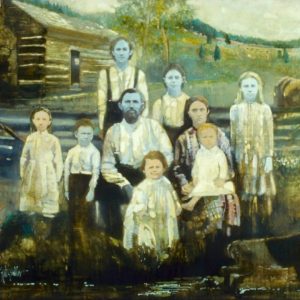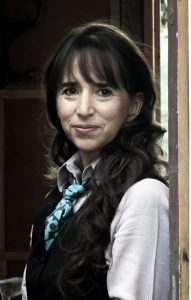The Antidote for Us Versus Them
 Hoax! On my screen was what looked like a painted daguerreotype family portrait from an era when people lived in hand-hewn log cabins, raised shoats, and wore dresses sewn from potato sacks, but what made this portrait surely a work of trickery was the color of the complexion of five family members: bright, shocking, no-doubt-about-it blue.
Hoax! On my screen was what looked like a painted daguerreotype family portrait from an era when people lived in hand-hewn log cabins, raised shoats, and wore dresses sewn from potato sacks, but what made this portrait surely a work of trickery was the color of the complexion of five family members: bright, shocking, no-doubt-about-it blue.
The caption could have been the script of a barker for a freak show. Definitely click-bait, I decided. Had I not been so intent on avoiding my task at hand – editing my novel-in-progress – I might have logged off and returned to my manuscript.
Instead: click.
Not a hoax at all, it turns out.
Commissioned by the now-defunct Science magazine, Cathy Trost’s accompanying article entitled “The Blue Fugates of Troublesome Creek” traced the family’s history back 200 hundred years to its origins to one Martin Fugate who settled on the banks of Troublesome Creek not too far from Hardburly and chose for his bride a fair-skinned redhead by the name of Elizabeth Smith.
Fugate himself was not blue, but as soon as he and Elizabeth started their family, out came one blue child after another, and rather than succumbing to what was believed to be lung or heart disorders, these children grew up, enjoyed robust health and lived to ripe old ages.
The Fugates, along with the three or four other families related to Elizabeth, clustered in isolation from the rest of the world in what was already a remote place, and because large families were typical in those days, it wasn’t long before those who were blue were not uncommon.
Trost’s article is hardly exhaustive on the subject and in some places factually incorrect, but at the time I was introduced to this medical rarity, hers was the only accessible record of blue people, apart from a couple of jargon-saturated entries in dry medical journals and a brief mention in the hematology chapter of a contemporary med-school textbook.
To get a sense of the stigmatizing, prejudice and social avoidance these families must have felt, I had to read between the lines, employ my imagination and draw from what I know about humans’ penchant for dividing into camps of Us and Them.
What is it about otherness that both fascinates us and makes us afraid? That question inspired me to write my novel, The Last Blue set in 1937. For generations, the blue people went without diagnosis, treatment or cure, subjects of suspicion and superstition, forced to live a life segregated from the rest of society, and surely targets of hostility, even cruelty.
Trost describes how famed hematologist Madison Cawein of the University of Kentucky finally solved the mystery of what caused this coloration, but I wanted to know what of the cure for prejudice? What heals the soul of a person who has been ostracized, who has been taught that the only way to stay safe is to stay hidden? And what is the curative for an ignorant community?
An anecdote in Trost’s article described how the old widower of “the bluest woman who ever lived” gave a congenial interview years ago, but when questioned about his wife’s unusual coloring, he would not agree that she had been blue, not because love is somehow colorblind. Instead, he knew all about blue but wouldn’t allow it to distinguish or define his wife, or their love for each other. I knew then that I couldn’t write about identity, belonging and family without writing about love.
Much of my research is thanks to the Works Progress Administration and the invaluable contribution made by its documentarians, those talented writers and photographers on the government dime who were dispatched across the country to document the plight of struggling Americans, whether battening down the hatches in Oklahoma or migrating to California.
Those documentarians assigned to Appalachia, an area that was still largely unknown in the 1930s and itself plagued by stereotypes, were instrumental in assisting me with historical accuracy. The Library of Congress has digitized much of their work, which means I was able to don a pair of headphones, close my eyes and be transported back 80 years to a tobacco field where a man behind a plough told about his livelihood, the state of education and what ticket he voted.
 It seemed fitting then that The Last Blue should begin with two WPA documentarians arriving in the fictionalized town of Chance in eastern Kentucky. Rather than heeding warnings to stay away from a strange family quarantined deep in a holler, they set off to investigate. What they discover is a woman and her family forced to isolate themselves because they are perceived to be different from others.
It seemed fitting then that The Last Blue should begin with two WPA documentarians arriving in the fictionalized town of Chance in eastern Kentucky. Rather than heeding warnings to stay away from a strange family quarantined deep in a holler, they set off to investigate. What they discover is a woman and her family forced to isolate themselves because they are perceived to be different from others.
Years of separation have heightened rather than alleviated the fears of the nearby townsfolk, deepening the mistrust between neighbors and causing tensions to flare into acts of violence. While The Last Blue is one woman’s unique journey to determine her own agency and destiny, a relevant parallel might be made to our current time of social distancing and sequestering in which we have endured varying degrees of loneliness, disconnectedness and not an insignificant amount of fear.
The Us and Them camps portrayed in the novel also echo some of our current divisions, which were seeded first by fear, then fed by frustration and distrust, and resulting in hostility. How the last blue woman and a dispirited photographer, principal characters in The Last Blue, overcome these antagonistic forces could be applied two centuries later during a pandemic in which neighbors find themselves at odds with each other. Hint: love has something to do with it. Not the fluffy kind. The kind that requires risk, self-examination, and trust. Self-sacrifice, even.
—
Isla Morley grew up in South Africa during apartheid. She is the author of Come Sunday, which won the Janet Heidinger Prize for Fiction and was a finalist for the Commonwealth Prize. Her novel Above was an IndieNext pick, and Best Buzz Book, and a Publishers Weekly Best New Book. She lives in the Los Angeles area with her husband, daughter, three cats, and five tortoises.
Twitter https://twitter.com/IslaMorley
Website http://www.islamorley.com/
THE LAST BLUE

The Last Blue, Isla Morley
The Last Blue is luminous narrative inspired by the fascinating real case of “the Blue People of Kentucky” that probes questions of identity, love, and family.
When a disillusioned photographer is sent to document remote recesses of Appalachia in 1937, where no outsiders have ever explored, he sees something that will haunt him into his old age—a woman whose skin is a shocking and unmistakable shade of blue.
From this happenstance meeting between a woman isolated from society and persecuted her whole life, and a man accustomed to keeping himself at lens distance from others, comes a mesmerizing story in which the dark shades of betrayal, prejudice, fear, and guilt, are refracted alongside the incandescent hues of passion, love and the courage that comes with being truly one of a kind.
BUY THE BOOK HERE https://bookshop.org/books/the-last-blue/9781643134185
Category: Contemporary Women Writers, On Writing























